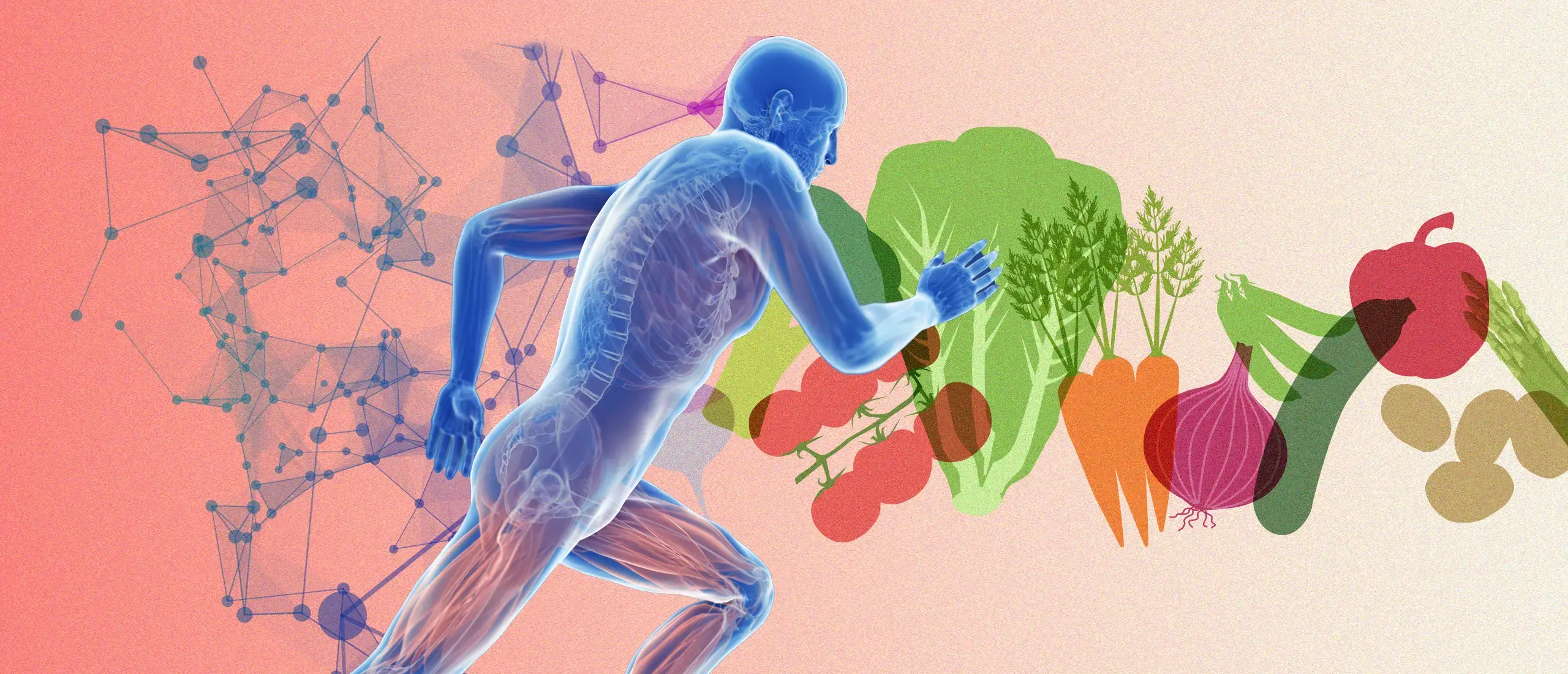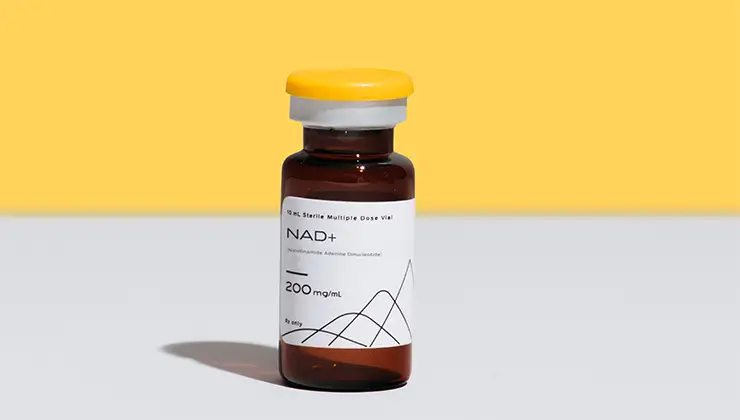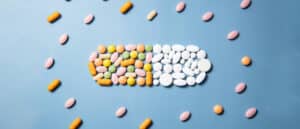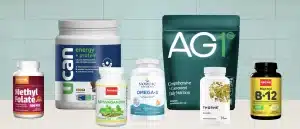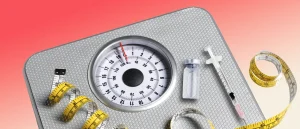NAD+ vs. NADH—What’s the Difference?
- By Jennifer Chesak
- Fact-checked by Mike Fazioli
- December 28, 2023
30-Second Takeaway
- NAD+ and NADH are both forms of NAD. Found in your body’s cells, NAD is an important coenzyme that switches between NAD+ and NADH to help your metabolism operate smoothly.
- You can get a majority of your NAD+ needs through diet alone, but there may be some circumstances in which supplementation could be beneficial. Be sure to consult with your physician before taking any new supplements.
As is the case with anything in life, there’s always going to be some give and take. You gain so much as you get older—from life wisdom to a stacked résumé, perhaps. But you also lose some things, particularly in the health department. One thing that declines is your level of nicotinamide adenine dinucleotide (NAD)—an important coenzyme, or a protein used by enzymes. You may have also heard of other forms of NAD, which include NAD+ and NADH.
What do all of these different acronyms even mean, and more importantly, why do they matter to you and your health? Here’s what you need to know: A steady loss of NAD can lead to inflammation, changes in metabolic health, and even the development of chronic disease. The good news? Research indicates that you can boost your NAD level via supplementation and lifestyle changes (1).
“We know that we need NAD,” says Anastasia Jandes, M.D., PharmD, IMFCP. “We know it depletes with age. We know that if it’s depleted, we are not vital.” In other words, we lose vitality when we lose NAD.
According to Jandes, we have more to learn about NAD, as well as NAD+ vs. NADH.
About the Expert
Anastasia Jandes, M.D., is a functional medicine doctor who is at the forefront of research on inflammation, chronic stress, sleep, and testosterone.
NAD+ vs NADH: What’s the Difference?
NAD is a simplified umbrella term used to describe NAD+ and NADH—again, it’s a coenzyme found in your cells—and is a derivative of various forms of vitamin B3, also called niacin.
NAD switches between NAD+ and NADH, which helps your metabolism function properly by helping your body turn food into energy (2).
But what’s the difference between these two chemical forms? NAD+ and NADH are known as “redox couples,” which means one is the reduced form and the other is the oxidized form. If a molecule is reduced, it’s gaining electrons, whereas if it’s oxidized, it’s losing electrons. NAD+ is the oxidized form of NADH. And NADH is the reduced form of NAD+ (2).
These two chemical types of NAD convert to one another to help turn the nutrients in your meals and snacks into energy your body can use to help you perform daily tasks—or crush that grueling HIIT workout.
How NAD+ and NADH Help Create Cellular Energy
To score usable energy, your cells must extract and convert the macronutrients from your food —think carbohydrates, fats, and proteins—into adenosine triphosphate, or ATP.
ATP is often referred to as your cells’ “energy currency” (3). Consider this analogy: If you want to buy groceries, you can’t head to the store with the gold belt buckle you inherited from your uncle. You would need to convert that loot into dollars. The same logic applies to your body. It requires a universal currency, ATP, to do the work of driving metabolic reactions, transporting substances across membranes, and performing mechanical work like contracting muscles.
NAD+ is what makes producing ATP possible. NAD+ converts to NADH and then back to NAD+ to do this (4).
So how does this all work in relation to food, exactly? Let’s say you eat a banana. The carbohydrates break down into sugar molecules, also known as glucose. In response to glucose entering the bloodstream, the pancreas will release some insulin. Insulin is a hormone that tells cells to open their “gates” and let glucose in. Once inside cells, glucose undergoes many reactions to get broken down—and NAD+ is involved in several of these reactions (4).
In a nutshell, as these reactions involving NAD+ occur, the molecules being broken down cast out an electron. And NAD+ essentially goes, “Hey, I’ll take that electron.” As NAD+ gains these electrons, it’s reduced to NADH. Then NADH hands over its newly acquired electrons to the enzymes that play a role in ATP production within your mitochondria—the powerhouse of cells.
After handing these electrons over to enzymes, NADH once again becomes NAD+ (4). Meanwhile, your body has now turned that banana into ATP, your cells’ universal energy currency.
NAD+ vs. NADH: Which Is Better?
Two strategies exist for boosting NAD+ levels: inhibiting pathways that consume NAD+, or stimulating NAD+ biosynthesis. The latter of these two strategies is what researchers appear to be currently focusing on (5).
So which form is better to take as a supplement? Taking NADH would likely not be an effective strategy for boosting NAD levels, Jandes suggests. Remember, NAD+ converts to NADH, and then back to NAD+, in the body.
What about NAD+ as a supplement? The truth is you likely don’t need any more than what you get from your diet alone. Your body uses NAD+ precursors, which are different forms of vitamin B3, to produce NAD+. NAD+ precursors include the following:
- Nicotinic acid (NA)
- Nicotinamide (NAM)
- Nicotinamide riboside (NR)
- Nicotinamide mononucleotide (NMN)
- Tryptophan
Several foods contain these compounds naturally. For example, NA is found in meat, fish, poultry, whole grains, nuts, and more. Fruits, vegetables, meat, and cow’s milk are all good sources of NR. And tryptophan is found in cow’s milk, cheese, egg whites, poultry, fish, and some seeds.
Jandes recommends three things to boost NAD+ naturally and help facilitate all the biochemical processes in the body related to energy production and more:
- Eating a colorful array of fruits and veggies weekly
- Getting adequate physical activity daily
- Staying hydrated throughout the day
Until more research becomes available on the amount of NAD+ levels you need as you age— which involves some caveats (noted below)—the safest way to supplement this is with vitamin B3.
Jandes recommends starting with a B complex vitamin, and one that has the correct amount of niacin in it. This is important because taking a supplement with too much niacin in it can cause flushing (redness and, sometimes, an itching and burning sensation of the skin) (6).
If you’re going to take a B complex vitamin, Jandes recommends purchasing an option that offers the recommended daily allowance (RDA) of 15 milligrams of niacin. B-Supreme from Designs for Health is her top choice. But checking in with your physician before taking any new vitamins, minerals, or over-the-counter drugs is always a good idea.
NAD Safety
Remember, research on NAD+ supplementation for longevity is still ongoing. Jandes notes that taking high-dose NAD without first measuring your levels is likely not a safe thing to do, or at least it’s yet to be proven safe by experts. One concern is that some cancers may use NAD/NADH pathways to thrive (7).
That’s why Jandes recommends following a healthy lifestyle (which can naturally boost NAD levels) and perhaps adding a good B complex vitamin if necessary. These may be the best practices until more research on cancer risk—which may come down to some individual factors, including family history—becomes available.
It should be. NAD+ may boost energy, increase lifespan, help with weight loss and improve brain function. Now available through Hone.
References
- Shin-ichiro Imai, et al. (2014). NAD+ and sirtuins in aging and disease.
- Xiao W, et al. (2018). NAD(H) and NADP(H) redox couples and cellular energy metabolism.
- Pinna S, et al. (2022). A prebiotic basis for ATP as the universal energy currency.
- Bonora M, et al. (2012). ATP synthesis and storage.
- Rubén Zapata‐Pérez, et al. (2021). NAD+ homeostasis in human health and disease.
- National Institutes of Health (NIH). (2022). Niacin.
- Keisuke Yaku, et al. (2018). NAD Metabolism in Cancer Therapeutics.



